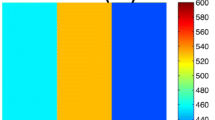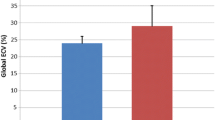Abstract
The aim of this study is to determine the contribution of strain ε cc in mid left ventricular (LV) segments to the reduction of composite LV circumferential ε cc in assess severity of duchenne muscular dystrophy (DMD) heart disease as assessed by cardiac magnetic resonance imaging (CMR). DMD patients and control subjects were stratified by age, LV ejection fraction, and late gadolinium enhancement (LGE) status. Tagged CMR images were analyzed for global ventricular function, LGE imaging, and composite and segmental ε cc. The relationship between changes in segmental ε cc changes and LGE across patient groups was assessed by a statistical step-down model. LV ε cc exhibited segmental heterogeneity; in control subjects and young DMD patients, ε cc was greatest in LV lateral free wall segments. However, with increasing age and cardiac disease severity as demonstrated by decreased EF and development of myocardial strain the segmental differences diminished. In subjects with advanced heart disease as evidenced by reduced LV ejection fraction and presence of LGE, very little segmental heterogeneity was present. In control subjects and young DMD patients, ε cc was greatest in LV lateral free wall segments. Increased DMD heart disease severity was associated with reduced composite; ε cc diminished regional ε cc heterogeneity and positive LGE imaging. Taken together, these findings suggest that perturbation of segmental, heterogeneous ε cc is an early biomarker of disease severity in this cross-section of DMD patients.



Similar content being viewed by others

References
Ashford MW Jr, Liu W, Lin SJ et al (2005) Occult cardiac contractile dysfunction in dystrophin-deficient children revealed by cardiac magnetic resonance strain imaging. Circulation 112(16):2462–2467
Bushby K, Muntoni F, Urtizberea A et al (2004) Report on the 124th ENMC International Workshop. Treatment of Duchenne muscular dystrophy; defining the gold standards of management in the use of corticosteroids. 2–4 April 2004, Naarden, The Netherlands. Neuromusc Disord 14(8–9):526–534
Cerqueira MD, Weissman NJ, Dilsizian et al (2002) Standardized myocardial segmentation and nomenclature for tomographic imaging of the heart: a statement for healthcare professionals from the Cardiac Imaging Committee of the Council on Clinical Cardiology of the American Heart Association. Circulation 105(4):539–542
Deconinck N, Dan B (2007) Pathophysiology of duchenne muscular dystrophy: current hypotheses. Pediatr Neurol 36:1–7
Eagle M, Baudouin SV, Chandler et al (2002) Survival in Duchenne muscular dystrophy: improvements in life expectancy since 1967 and the impact of home nocturnal ventilation. Neuromusc Disord 12(10):926–929
Finder JD, Birnkrant D, Carl J et al (2004) Respiratory care of the patient with Duchenne muscular dystrophy: ATS consensus statement. Am J Respir Crit Care Med 170(4):456–465
Finsterer J, Stollberger C (2003) The heart in human dystrophinopathies. Cardiology 99(1):1–19
Fong PY, Turner PR, Denetclaw WF et al (1990) Increased activity of calcium leak channels in myotubes of Duchenne human and mdx mouse origin. Science 250(4981):673–676
Garot J, Bluemke DA, Soman NF et al (2000) Fast determination of regional myocardial strain fields from tagged cardiac images using harmonic phase MRI. Circulation 101(9):981–988
Gotte MJ, German T, Russel IK et al (2006) Myocardial strain and torsion quantified by cardiovascular magnetic resonance tissue tagging: studies in normal and impaired left ventricular function. J Am Coll Cardiol 48(10):2002–2011
Hagenbuch SC, Gottliebson WM, Wansapura J et al (2010) Detection of progressive cardiac dysfunction by serial evaluation of circumferential strain in patients with Duchenne muscular dystrophy. Am J Cardiol 105(10):1451–1455
Hinton DP, Wald LL, Pitts J et al (2003) Comparison of cardiac MRI on 1.5 and 3.0 Tesla clinical whole body systems. Invest Radiol 38(7):436–442
Hor KN, Wansapura J, Markham LW (2009) Circumferential strain analysis identifies strata of cardiomyopathy in Duchenne muscular dystrophy. J Am Coll Cardiol 53:1204–1210
Hor K, Taylor MD, Al-Khalidi HR et al. (2013) Prevalence and distribution of late gadolinium enhancement in a large population of patients with Duchenne muscular dystrophy: effect of age and left ventricular systolic function. J Cardiovasc Magn Reson 15:107
Ingels NB Jr, Hansen DE, Daughters GT et al (1989) Relation between longitudinal, circumferential, and oblique shortening and torsional deformation in the left ventricle of the transplanted human heart. Circ Res 64(5):915–927
Macedo R, Schmidt A, Rochitte CE et al (2007) MRI to assess arrhythmia and cardiomyopathies: relationship to echocardiography. Echocardiography 24(2):194–206
Markham LW, Spicer RL, Cripe LH (2005) The heart in muscular dystrophy. Pediatr Ann 34(7):531–535
McCrohon JA, Moon JC, Prasad SK et al (2003) Differentiation of heart failure related to dilated cardiomyopathy and coronary artery disease using gadolinium-enhanced cardiovascular magnetic resonance. Circulation 108(1):54–59
Moore CC, Lugo-Olivieri CH, McVeigh ER et al (2000) Three-dimensional systolic strain patterns in the normal human left ventricle: characterization with tagged MR imaging. Radiology 214(2):453–466
Ortiz-Perez JT, Rodriguez J, Meyers SN et al (2008) Correspondence between the 17-segment model and coronary arterial anatomy using contrast-enhanced cardiac magnetic resonance imaging. J Am Coll Cardiol Imaging 1(3):282–293
Osman NF, Prince JL (2004) Regenerating MR tagged images using harmonic phase (HARP) methods. IEEE Trans Biomed Eng 51(8):1428–1433
Osman NF, Kerwin WS, McVeigh ER et al (1999) Cardiac motion tracking using CINE harmonic phase (HARP) magnetic resonance imaging. Magn Reson Med 42(6):1048–1060
Osman NF, McVeigh ER, Prince JL (2000) Imaging heart motion using harmonic phase MRI. IEEE Trans Med Imaging 19(3):186–202
Pennell DJ, Senchtem UP, Higgins CB et al (2004) Clinical indications for cardiovascular magnetic resonance (CMR): Consensus Panel report. J Cardiovasc Magn Reson 6(4):727–765
Pohost GM, Hung L, Doyle M (2003) Clinical use of cardiovascular magnetic resonance. Circulation 108(6):647–653
Puchalski MD et al (2009) Late gadolinium enhancement: precursor to cardiomyopathy in Duchenne muscular dystrophy? Int J Cardiovasc Imaging 25(1):57–63
Sato Y, Maruyama A, Ichihashi K (2012) Myocardial strain of the left ventricle in normal children. J Cardiol 60:145–149
Schmidt A, Azevedo CF, Cheng A et al (2007) Infarct tissue heterogeneity by magnetic resonance imaging identifies enhanced cardiac arrhythmia susceptibility in patients with left ventricular dysfunction. Circulation 115(15):2006–2014
Shigihara-Yasuda K, Tonoki H, Goto Y et al (1992) A symptomatic female patient with Duchenne muscular dystrophy diagnosed by dystrophin-staining: a case report. Eur J Pediatr 151(1):66–68
Valeti VU, Chun W, Potter DD et al (2006) Myocardial tagging and strain analysis at 3 Tesla: comparison with 1.5 Tesla imaging. J Magn Reson Imaging 23(4):477–480
van der Geest RJ, Buller VG, Jansen E et al (1997) Comparison between manual and semiautomated analysis of left ventricular volume parameters from short-axis MR images. J Comput Assist Tomogr 21(5):756–765
Wansapura J, Fleck R, Crotty E et al (2006) Frequency scouting for cardiac imaging with SSFP at 3 Tesla. Pediatr Radiol 36(10):1082–1085
White JA, Patel MR (2007) The role of cardiovascular MRI in heart failure and the cardiomyopathies. Cardiol Clin 25(1):71–95, vi
Williams IA, Allen DG (2007) The role of reactive oxygen species in the hearts of dystrophin-deficient mdx mice. Am J Physiol Heart Circ Physiol 293(3):H1969–H1977
Young AA, Imai H, Chang CN et al (1994) Two-dimensional left ventricular deformation during systole using magnetic resonance imaging with spatial modulation of magnetization. Circulation 89(2):740–752
Author information
Authors and Affiliations
Corresponding author
Appendix
Appendix
Descriptive Phase
We computed a difference in segmental ε cc across groups and segments via the Eq. (1) as
To determine if segmental ε cc could predict the presence of MDE, we specifically focused on ∆ε cc by segment from group B subjects (no MDE—early disease) to group E subjects (positive MDE state, advanced disease).
Inferential Phase
The full model consisted of main effects and interaction effects between disease state (subject groups A-E) and LV ε cc in segments 7–12. As such, a 5 × 6 (disease state x segment) split-plot design with unbalanced cells was used for this analysis with both group and segment modeled as fixed effects and subjects nested within groups as our lone random effect (see Eq. 2).
where α j = main effect of group; ρ i(j) = whole-plot error; β k = main effect of segment; (αβ) jk = interaction term; and ω ijk = split-plot error.
The two error terms, ρ i(j) and ω ijk , were assumed to be normally, independently, and identically distributed with mean 0 and variance components σ 2 ρ and σ 2 ω , respectively. Moreover, it was assumed that the whole-plot error variance (σ 2 ρ ) and split-plot error variance (σ 2 ω ) are independent of each other.
Rights and permissions
About this article
Cite this article
Hor, K.N., Kissoon, N., Mazur, W. et al. Regional Circumferential Strain is a Biomarker for Disease Severity in Duchenne Muscular Dystrophy Heart Disease: A Cross-Sectional Study. Pediatr Cardiol 36, 111–119 (2015). https://doi.org/10.1007/s00246-014-0972-9
Received:
Accepted:
Published:
Issue Date:
DOI: https://doi.org/10.1007/s00246-014-0972-9



